The global FFS rigid films market is valued at USD 6,847 million in 2025 and is set to reach USD 12,146.7 million by 2035, growing at a CAGR of 5.9%. The market stands at the forefront of a transformative decade that promises to redefine automated packaging infrastructure and form-fill-seal excellence across food processing, pharmaceutical manufacturing, consumer goods, and industrial sectors. The market's journey from USD 6,847 million in 2025 to USD 12,146.7 million by 2035 represents substantial growth, demonstrating the accelerating adoption of automated packaging solutions and sophisticated barrier protection systems across production lines, sterile filling operations, liquid packaging, and unit dose applications.
The first half of the decade (2025-2030) will witness the market climbing from USD 6,847 million to approximately USD 8,903 million, adding USD 2,056 million in value, which constitutes 39% of the total forecast growth period. This phase will be characterized by the rapid adoption of high-speed form-fill-seal systems, driven by increasing demand for automated packaging efficiency and enhanced barrier requirements worldwide. Superior moisture protection capabilities and contamination prevention features will become standard expectations rather than premium options.
The latter half (2030-2035) will witness sustained growth from USD 8,903 million to USD 12,146.7 million, representing an addition of USD 3,253 million or 61% of the decade's expansion. This period will be defined by mass market penetration of specialized FFS rigid film systems, integration with comprehensive packaging automation platforms, and seamless compatibility with existing production line infrastructure. The market trajectory signals fundamental shifts in how food processors and pharmaceutical manufacturers approach automated packaging solutions, with participants positioned to benefit from sustained demand across multiple application segments.
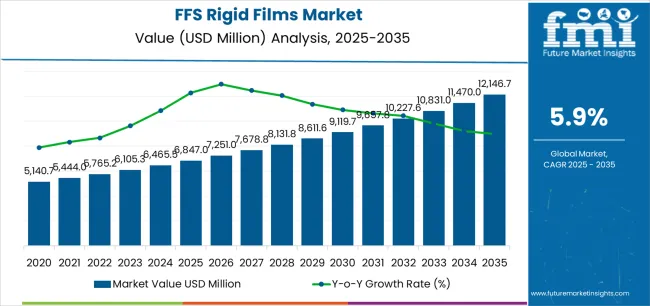
The FFS rigid films market demonstrates distinct growth phases with varying market characteristics and competitive dynamics. Between 2025 and 2030, the market progresses through its automated packaging adoption phase, expanding from USD 6,847 million to USD 8,903 million with steady annual increments averaging 5.4% growth. This period showcases the transition from standard thermoforming films to advanced systems with enhanced puncture resistance and integrated barrier properties becoming mainstream features.
The 2025-2030 phase adds USD 2,056 million to market value, representing 39% of total decade expansion. Market maturation factors include standardization of film specifications, declining material costs for specialty barrier coatings, and increasing manufacturer awareness of FFS benefits reaching 70-75% effectiveness in automated packaging applications. Competitive landscape evolution during this period features established manufacturers like Amcor and Berry Global expanding their product portfolios while new entrants focus on specialized oxygen barrier solutions and enhanced seal strength technology.
According to FMI’s report series on packaging circularity and compliance under EU and US regulatory frameworks, from 2030 to 2035, market dynamics shift toward advanced customization and multi-sector deployment, with growth accelerating from USD 8,903 million to USD 12,146.7 million, adding USD 3,253 million or 61% of total expansion. This phase transition logic centers on universal FFS rigid film systems, integration with high-speed packaging equipment, and deployment across diverse application scenarios, becoming standard rather than specialized packaging formats. The competitive environment matures with focus shifting from basic material quality to comprehensive barrier performance and compatibility with sterile processing operations.
| Metric | Value |
|---|---|
| Market Value (2025) | USD 6,847 million |
| Market Forecast (2035) | USD 12,146.7 million |
| Growth Rate | 5.9% CAGR |
| Leading Material Type | Polypropylene |
| Primary Application | Food & Beverage Segment |
The market demonstrates strong fundamentals with polypropylene systems capturing a dominant share through superior thermoforming capabilities and cost-effective processing characteristics. Food & beverage applications drive primary demand, supported by increasing packaged food consumption requirements and automated production line management solutions. Geographic expansion remains concentrated in developed markets with established food processing infrastructure, while emerging economies show accelerating adoption rates driven by packaged goods consumption and rising manufacturing activity.
Market expansion rests on three fundamental shifts driving adoption across food processing and pharmaceutical sectors. Automation advancement creates compelling advantages through FFS rigid film systems that provide comprehensive barrier protection with integrated production efficiency, enabling manufacturers to achieve sterile packaging and quality preservation while maintaining high-speed operations and justifying investment over manual packaging methods. Food safety intensification accelerates as processing facilities worldwide seek reliable packaging systems that deliver contamination prevention directly to consumer delivery, enabling product protection that aligns with regulatory standards and minimizes spoilage losses. Production efficiency drives adoption from manufacturers requiring automated packaging solutions that maximize throughput while maintaining package integrity during filling and sealing operations.
However, growth faces headwinds from equipment compatibility variations that differ across machine manufacturers regarding film specifications and thermoforming parameters, potentially limiting performance reliability in high-speed production categories. Material recycling infrastructure also persists regarding end-of-life management and multilayer separation that may increase operational complexity in markets with demanding waste reduction standards.
The FFS rigid films market represents a compelling intersection of automated packaging innovation, barrier protection enhancement, and production efficiency management. With robust growth projected from USD 6,847 million in 2025 to USD 12,146.7 million by 2035 at a 5.9% CAGR, this market is driven by increasing food safety trends, pharmaceutical sterility requirements, and commercial demand for high-speed packaging formats.
The market's expansion reflects a fundamental shift in how food processors and pharmaceutical manufacturers approach automated packaging infrastructure. Strong growth opportunities exist across diverse applications, from food processing operations requiring barrier protection to pharmaceutical facilities demanding sterile packaging solutions. Geographic expansion is particularly pronounced in Asia-Pacific markets, led by China (7.2% CAGR) and India (6.9% CAGR), while established markets in North America and Europe drive innovation and specialized segment development.
The dominance of polypropylene systems and food & beverage applications underscores the importance of proven thermoforming technology and barrier integrity in driving adoption. Material compatibility and equipment integration remain key challenges, creating opportunities for companies that can deliver reliable performance while maintaining production efficiency.
Primary Classification: The market segments by material type into polypropylene, polyethylene, polystyrene, and PET categories, representing the evolution from basic thermoforming materials to advanced barrier films for comprehensive packaging operations.
Secondary Breakdown: Application segmentation divides the market into food & beverage, pharmaceutical, personal care, industrial, and others sectors, reflecting distinct requirements for barrier protection, seal integrity, and contamination prevention.
Regional Classification: Geographic distribution covers North America, Europe, Asia Pacific, Latin America, and the Middle East & Africa, with developed markets leading innovation while emerging economies show accelerating growth patterns driven by packaged goods consumption programs.
The segmentation structure reveals technology progression from standard polypropylene films toward integrated multi-layer platforms with enhanced barrier and mechanical capabilities, while application diversity spans from food processing operations to pharmaceutical facilities requiring comprehensive sterile protection and long-term stability solutions.
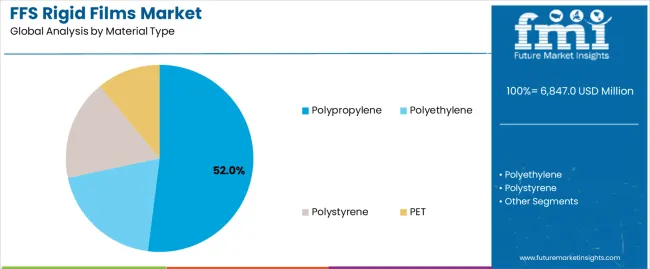
Polypropylene segment is estimated to account for 52% of the FFS rigid films market share in 2025. The segment's leading position stems from its fundamental role as a critical component in automated packaging applications and its extensive use across multiple food processing and pharmaceutical sectors. Polypropylene's dominance is attributed to its superior thermoforming flexibility, including temperature resistance, clarity properties, and cost-effective processing that make it indispensable for form-fill-seal operations.
Market Position: Polypropylene systems command the leading position in the FFS rigid films market through advanced coextrusion technologies, including comprehensive thickness options, barrier versatility, and reliable sealing performance that enable manufacturers to deploy packaging solutions across diverse production environments.
Value Drivers: The segment benefits from processor preference for proven thermoplastic materials that provide exceptional formability without requiring specialized equipment modifications. Cost-effective manufacturing processes enable deployment in food packaging, pharmaceutical containers, and consumer goods applications where barrier performance and processing efficiency represent critical selection requirements.
Competitive Advantages: Polypropylene systems differentiate through excellent heat seal performance, proven optical clarity, and compatibility with standard FFS machinery that enhance packaging capabilities while maintaining economical operational profiles suitable for diverse automated packaging applications.
Key market characteristics:
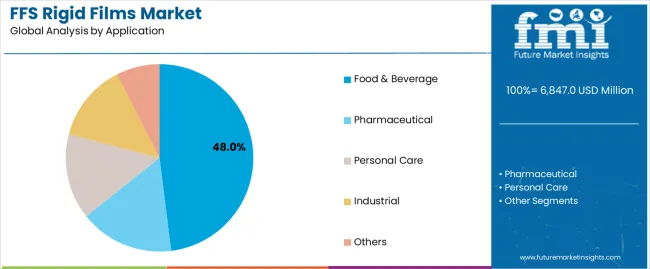
Food & beverage segment is projected to hold 48% of the FFS rigid films market share in 2025. The segment's market leadership is driven by the extensive use of FFS rigid films in dairy packaging, liquid filling, portion control, and ready-meal containers, where packaging serves as both a product protection barrier and freshness preservation tool. The food processing industry's consistent investment in automated packaging materials supports the segment's dominant position.
Market Context: Food & beverage applications dominate the market due to widespread adoption of form-fill-seal technology and increasing focus on food safety management, extended shelf-life, and tamper-evident applications that enhance product quality while maintaining consumer confidence.
Appeal Factors: Food processors prioritize barrier integrity, seal reliability, and integration with filling equipment that enable coordinated production across multiple product lines. The segment benefits from substantial regulatory requirements and food safety standards that emphasize reliable packaging for processed food and beverage applications.
Growth Drivers: Convenience food consumption incorporates FFS rigid films as standard packaging for dairy products and liquid foods. At the same time, food processing industry initiatives are increasing demand for automated packaging systems that comply with hygiene standards and enhance production throughput.
Market Challenges: Material migration concerns and flavor scalping may limit deployment flexibility in highly acidic products or long shelf-life scenarios.
Application dynamics include:
Growth Accelerators: Manufacturing automation drives primary adoption as FFS rigid film systems provide exceptional packaging efficiency that enable high-speed production without excessive labor investment, supporting product protection and line productivity that require automated packaging formats. Food safety expansion accelerates market growth as processing facilities seek contamination-free packaging solutions that maintain product integrity during filling while enhancing consumer confidence through reliable barrier systems. Packaged goods consumption increases worldwide, creating sustained demand for automated packaging systems that complement production operations and provide competitive advantages in manufacturing efficiency.
Growth Inhibitors: Equipment compatibility challenges differ across machinery manufacturers regarding film specifications and thermoforming parameters, which may limit market penetration and reliability in high-speed categories with demanding production requirements. Material recycling complexity persists regarding multilayer separation and chemical recovery that may increase disposal costs in large-scale applications with specialized waste management standards. Market fragmentation across multiple polymer types and barrier specifications creates compatibility concerns between different packaging formats and existing production infrastructure.
Market Evolution Patterns: Adoption accelerates in food processing and pharmaceutical sectors where barrier protection justifies material investments, with geographic concentration in developed markets transitioning toward mainstream adoption in emerging economies driven by packaged goods consumption and manufacturing modernization. Technology development focuses on enhanced oxygen barriers, improved puncture resistance, and integration with intelligent packaging systems that optimize product protection and quality assurance. The market could face disruption if alternative packaging materials or technology innovations significantly challenge FFS film advantages in automated applications.
The FFS rigid films market demonstrates varied regional dynamics with Growth Leaders including China (7.2% CAGR) and India (6.9% CAGR) driving expansion through packaged goods consumption and manufacturing modernization. Steady Performers encompass the USA (6.5% CAGR), Germany (5.8% CAGR), and Japan (5.5% CAGR), benefiting from established food processing sectors and pharmaceutical manufacturing adoption.
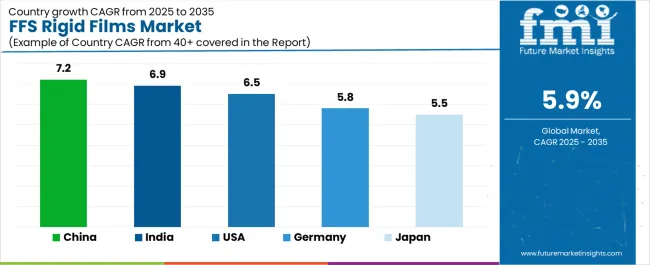
| Country | CAGR (2025-2035) |
|---|---|
| China | 7.2% |
| India | 6.9% |
| USA | 6.5% |
| Germany | 5.8% |
| Japan | 5.5% |
Regional synthesis reveals Asia-Pacific markets leading growth through food processing expansion and pharmaceutical development, while European countries maintain steady expansion supported by specialized dairy applications and healthcare packaging requirements. North American markets show strong growth driven by convenience food manufacturing and beverage processing applications.
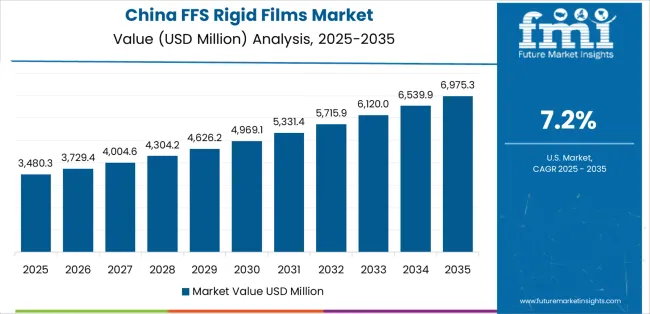
China establishes regional leadership through explosive food processing expansion and comprehensive pharmaceutical modernization, integrating advanced FFS rigid film systems as standard components in automated packaging lines and sterile filling applications. The country's 7.2% CAGR through 2035 reflects government initiatives promoting domestic manufacturing and food safety programs that mandate the use of automated packaging systems in processing operations. Growth concentrates in major manufacturing regions, including Pearl River Delta, Yangtze River Delta, and Bohai Economic Rim, where production facilities showcase integrated FFS film systems that appeal to domestic processors seeking reliable barrier protection and international quality standards.
Chinese manufacturers are developing innovative FFS film solutions that combine local production advantages with international barrier specifications, including multi-layer construction and advanced oxygen scavenging capabilities.
Strategic Market Indicators:
The Indian market emphasizes food & beverage applications, including rapid packaged goods development and comprehensive dairy expansion that increasingly incorporates FFS rigid films for liquid filling and portion control applications. The country is projected to show a 6.9% CAGR through 2035, driven by massive food processing investment under government manufacturing programs and commercial demand for affordable, reliable packaging systems. Indian processing facilities prioritize cost-effectiveness with FFS films delivering barrier protection through economical material usage and efficient production capabilities.
Technology deployment channels include major dairy cooperatives, beverage manufacturers, and pharmaceutical companies that support high-volume usage for domestic and export applications.
Performance Metrics:
The USA market emphasizes advanced FFS film features, including innovative barrier technologies and integration with comprehensive food safety platforms that manage packaging integrity, contamination prevention, and traceability applications through unified production systems. The country is projected to show a 6.5% CAGR through 2035, driven by convenience food expansion under consumer demand patterns and commercial requirement for reliable, high-speed packaging systems. American food processors prioritize production efficiency with FFS films delivering comprehensive protection through advanced seal systems and modified atmosphere compatibility.
Technology deployment channels include major food manufacturers, pharmaceutical companies, and contract packaging facilities that support custom development for high-speed operations.
Performance Metrics:
In Bavaria, North Rhine-Westphalia, and Baden-Württemberg, German food processors and pharmaceutical manufacturers are implementing advanced FFS rigid film systems to enhance packaging capabilities and support production efficiency that aligns with quality protocols and hygiene standards. The German market demonstrates sustained growth with a 5.8% CAGR through 2035, driven by food processing innovation programs and pharmaceutical facility investments that emphasize reliable automated packaging for manufacturing and filling applications. German processing facilities are prioritizing FFS film systems that provide exceptional barrier integrity while maintaining compliance with food contact regulations and minimizing contamination risk, particularly important in dairy processing and injectable pharmaceutical operations.
Market expansion benefits from food safety programs that mandate automated packaging in processing specifications, creating sustained demand across Germany's food and pharmaceutical sectors, where barrier performance and material purity represent critical requirements.
Strategic Market Indicators:
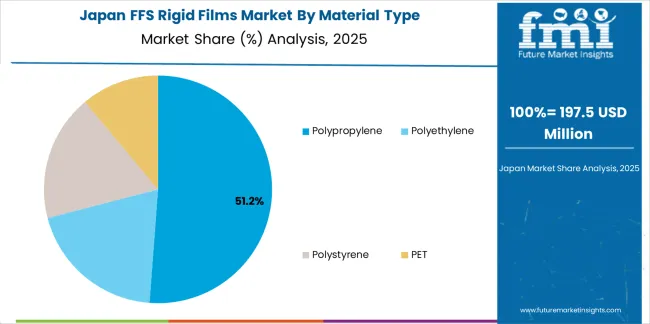
Japan's sophisticated food processing market demonstrates meticulous FFS film deployment, growing at 5.5% CAGR, with documented operational excellence in dairy packaging and pharmaceutical applications through integration with existing production systems and quality assurance infrastructure. The country leverages engineering expertise in polymer science and manufacturing precision to maintain market leadership. Processing centers, including Tokyo, Osaka, and Nagoya, showcase advanced installations where FFS rigid film systems integrate with comprehensive filling platforms and cleanroom management systems to optimize packaging integrity and product preservation.
Japanese food processors prioritize barrier precision and seal reliability in packaging development, creating demand for premium FFS film systems with advanced features, including ultra-low oxygen permeation and integration with aseptic processing protocols. The market benefits from established food processing infrastructure and willingness to invest in specialized packaging technologies that provide superior product protection and regulatory compliance.
Market Intelligence Brief:
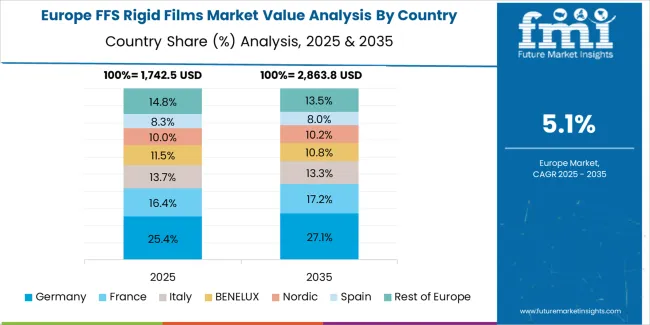
The FFS rigid films market in Europe is projected to grow from USD 1,773 million in 2025 to USD 2,896 million by 2035, registering a CAGR of 5.0% over the forecast period. Germany is expected to maintain its leadership position with a 38.2% market share in 2025, declining slightly to 37.8% by 2035, supported by its food processing excellence and major dairy centers, including Bavaria and Baden-Württemberg.
France follows with a 26.3% share in 2025, projected to reach 26.7% by 2035, driven by comprehensive dairy production and beverage manufacturing initiatives. The United Kingdom holds a 16.2% share in 2025, expected to maintain 16.5% by 2035 through established food processing sectors and pharmaceutical manufacturing adoption. Italy commands a 9.8% share, while Spain accounts for 7.4% in 2025. The Rest of Europe region is anticipated to gain momentum, expanding its collective share from 2.1% to 2.5% by 2035, attributed to increasing food processing development in Eastern European countries and emerging Nordic dairy facilities implementing automated packaging programs.
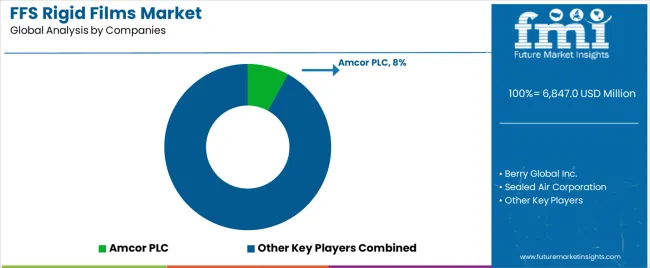
The FFS rigid films market operates with moderate concentration, featuring approximately 20-28 participants, where leading companies control roughly 40-48% of the global market share through established converter networks and comprehensive material science capabilities. Competition emphasizes barrier performance, seal integrity, and processing compatibility rather than price-based rivalry.
Market leaders encompass Amcor plc, Berry Global Inc., and Sealed Air Corporation, which maintain competitive advantages through extensive polymer expertise, global manufacturing networks, and comprehensive film engineering capabilities that create processor loyalty and support technical requirements. These companies leverage decades of packaging film experience and ongoing barrier technology investments to develop advanced FFS rigid film systems with exceptional protection and production features.
Specialty challengers include Coveris Holdings SA, Constantia Flexibles Group, and Winpak Ltd, which compete through specialized pharmaceutical packaging focus and innovative multilayer solutions that appeal to food processors seeking high-barrier formats and custom formulation flexibility. These companies differentiate through material science emphasis and specialized application focus.
Market dynamics favor participants that combine reliable barrier performance with advanced processing support, including thickness optimization and seal parameter capabilities. Competitive pressure intensifies as traditional flexible film manufacturers expand into rigid FFS systems. At the same time, specialized thermoforming companies challenge established players through innovative polymer solutions and cost-effective production targeting emerging food processing segments.
| Item | Value |
|---|---|
| Quantitative Units | USD 6,847 million |
| Material Type | Polypropylene, Polyethylene, Polystyrene, PET |
| Application | Food & Beverage, Pharmaceutical, Personal Care, Industrial, Others |
| Regions Covered | North America, Europe, Asia Pacific, Latin America, Middle East & Africa |
| Countries Covered | USA, Germany, Japan, China, India, and 25+ additional countries |
| Key Companies Profiled | Amcor plc, Berry Global Inc., Sealed Air Corporation, Coveris Holdings SA, Constantia Flexibles Group, Winpak Ltd |
| Additional Attributes | Dollar sales by material type and application categories, regional adoption trends across North America, Europe, and Asia-Pacific, competitive landscape with flexible packaging manufacturers and thermoforming specialists, processor preferences for barrier integrity and seal reliability, integration with automated filling equipment and production systems, innovations in multilayer technology and oxygen barrier construction, and development of specialized packaging solutions with enhanced product protection and contamination prevention capabilities |
The global FFS rigid films market is estimated to be valued at USD 6,847.0 million in 2025.
The market size for the FFS rigid films market is projected to reach USD 12,146.7 million by 2035.
The FFS rigid films market is expected to grow at a 5.9% CAGR between 2025 and 2035.
The key product types in FFS rigid films market are polypropylene, polyethylene, polystyrene and pet.
In terms of application, food & beverage segment to command 48.0% share in the FFS rigid films market in 2025.






Full Research Suite comprises of:
Market outlook & trends analysis
Interviews & case studies
Strategic recommendations
Vendor profiles & capabilities analysis
5-year forecasts
8 regions and 60+ country-level data splits
Market segment data splits
12 months of continuous data updates
DELIVERED AS:
PDF EXCEL ONLINE
Market Share Insights of FFS Rigid Film Manufacturers
Offshore Wind Market Forecast and Outlook 2025 to 2035
Offshore Wind Turbine Bearing Market Size and Share Forecast Outlook 2025 to 2035
Offshore Platform Electrification Market Size and Share Forecast Outlook 2025 to 2035
Offset Ink Market Size and Share Forecast Outlook 2025 to 2035
Offshore Drilling Riser Market Size and Share Forecast Outlook 2025 to 2035
Offshore Crane Market Size and Share Forecast Outlook 2025 to 2035
Offshore Wind Turbine Blade Market Size and Share Forecast Outlook 2025 to 2035
Offshore Wind Turbine Market Size and Share Forecast Outlook 2025 to 2035
Offshore Pipeline Infrastructure Market Size and Share Forecast Outlook 2025 to 2035
Offshore Wind Energy Market Size and Share Forecast Outlook 2025 to 2035
Offshore Structural Analysis Software Market Size and Share Forecast Outlook 2025 to 2035
Offshore ROV Market Growth – Trends & Forecast 2024-2034
Offshore Equipment Market
Offshore Wind Energy Infrastructure Market
Earmuffs Market Size and Share Forecast Outlook 2025 to 2035
Fixed Offshore Wind Energy Market Size and Share Forecast Outlook 2025 to 2035
Carbon Offset Platform Market Size and Share Forecast Outlook 2025 to 2035
Export Offshore Wind Cable Market Size and Share Forecast Outlook 2025 to 2035
Floating Offshore Wind Energy Market Size and Share Forecast Outlook 2025 to 2035

Thank you!
You will receive an email from our Business Development Manager. Please be sure to check your SPAM/JUNK folder too.
Chat With
MaRIA